Team and Group Dynamics: Case Study Analysis and Recommendations
VerifiedAdded on 2023/03/31
|16
|3705
|306
Report
AI Summary
This report provides a comprehensive analysis of team and group dynamics within an organization, addressing the benefits and drawbacks of adopting a team-oriented workplace. It delves into the impact of group dynamics on decision-making effectiveness, exploring factors such as team structure, leadership, and individual attributes. The report also examines key change management strategies, including incentives, cultural value redefinition, and authority exercise, that can be implemented to facilitate a successful transition. Practical implications of team strategy and group dynamics are discussed, with recommendations to improve organizational operations. The report is based on a case study of a governmental organization and incorporates relevant literature to support its findings and conclusions.
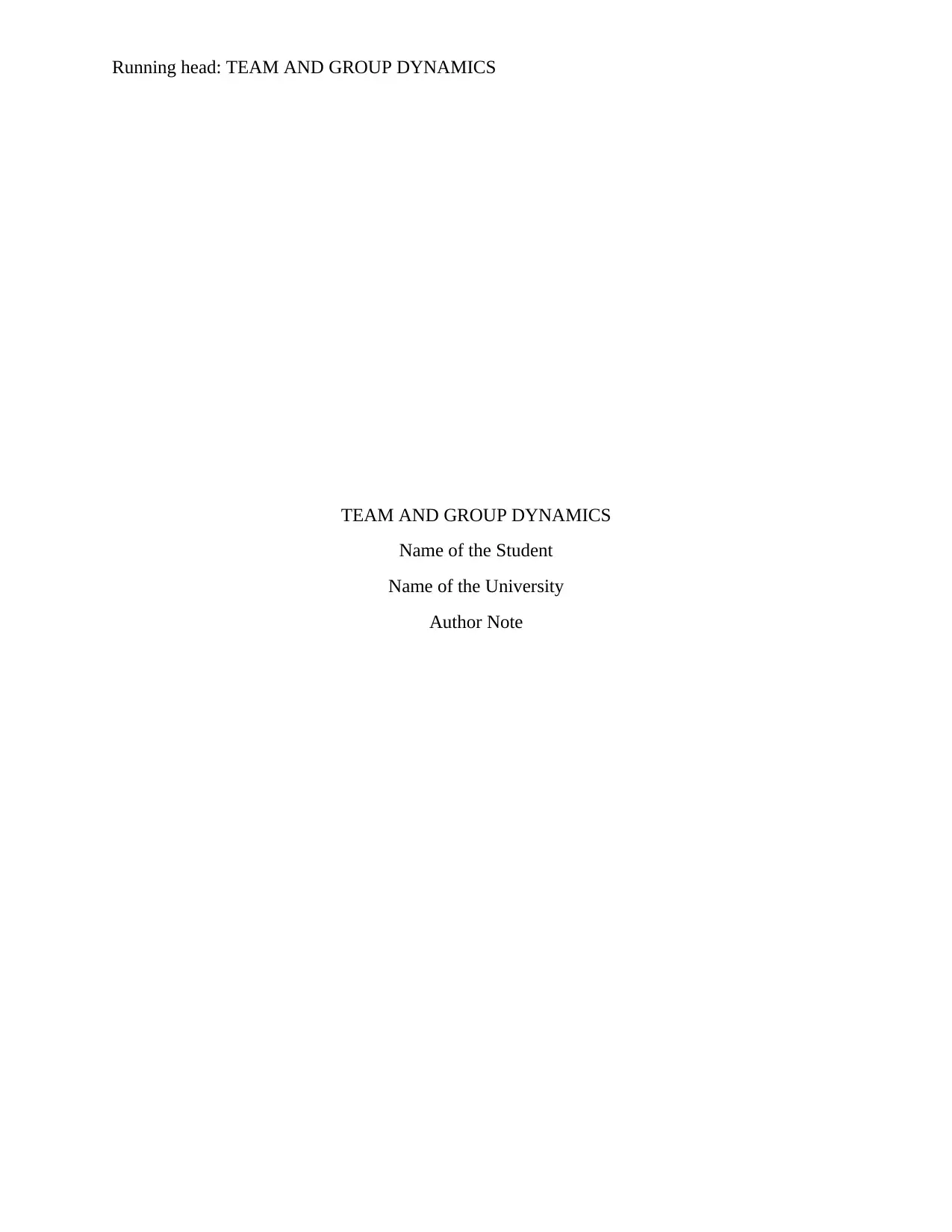
Running head: TEAM AND GROUP DYNAMICS
TEAM AND GROUP DYNAMICS
Name of the Student
Name of the University
Author Note
TEAM AND GROUP DYNAMICS
Name of the Student
Name of the University
Author Note
Paraphrase This Document
Need a fresh take? Get an instant paraphrase of this document with our AI Paraphraser
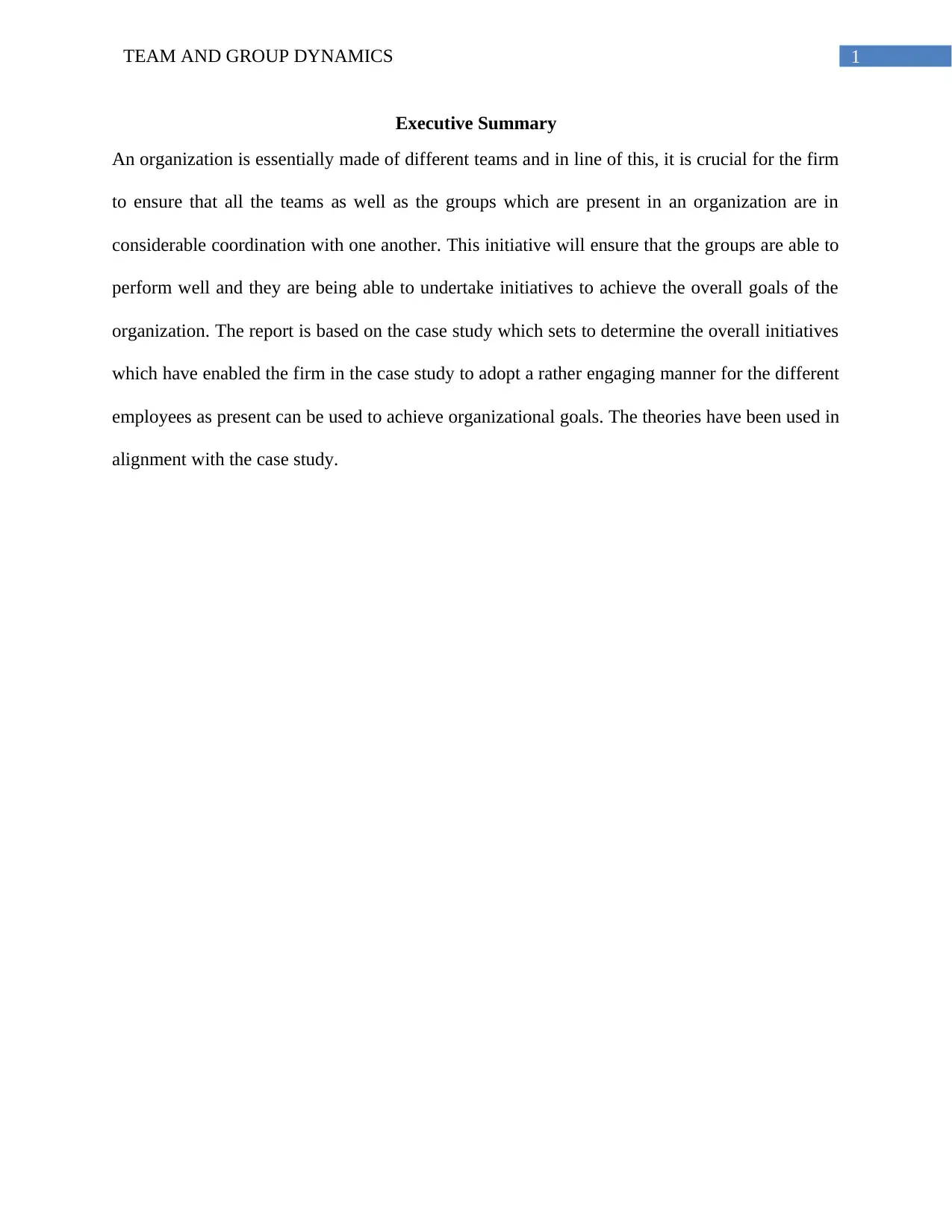
1TEAM AND GROUP DYNAMICS
Executive Summary
An organization is essentially made of different teams and in line of this, it is crucial for the firm
to ensure that all the teams as well as the groups which are present in an organization are in
considerable coordination with one another. This initiative will ensure that the groups are able to
perform well and they are being able to undertake initiatives to achieve the overall goals of the
organization. The report is based on the case study which sets to determine the overall initiatives
which have enabled the firm in the case study to adopt a rather engaging manner for the different
employees as present can be used to achieve organizational goals. The theories have been used in
alignment with the case study.
Executive Summary
An organization is essentially made of different teams and in line of this, it is crucial for the firm
to ensure that all the teams as well as the groups which are present in an organization are in
considerable coordination with one another. This initiative will ensure that the groups are able to
perform well and they are being able to undertake initiatives to achieve the overall goals of the
organization. The report is based on the case study which sets to determine the overall initiatives
which have enabled the firm in the case study to adopt a rather engaging manner for the different
employees as present can be used to achieve organizational goals. The theories have been used in
alignment with the case study.

2TEAM AND GROUP DYNAMICS
Table of Contents
Introduction......................................................................................................................................3
Literature review..............................................................................................................................3
Teams in an organization.............................................................................................................3
Group dynamics...........................................................................................................................5
Impact on group decision making effectiveness..........................................................................6
Change Management strategies...................................................................................................6
Practical implications.......................................................................................................................8
Team strategy...............................................................................................................................8
Dynamics of the group and impact on decision making..............................................................8
Key change management strategies to be applied.......................................................................9
Recommendations and Conclusion................................................................................................10
References......................................................................................................................................12
Table of Contents
Introduction......................................................................................................................................3
Literature review..............................................................................................................................3
Teams in an organization.............................................................................................................3
Group dynamics...........................................................................................................................5
Impact on group decision making effectiveness..........................................................................6
Change Management strategies...................................................................................................6
Practical implications.......................................................................................................................8
Team strategy...............................................................................................................................8
Dynamics of the group and impact on decision making..............................................................8
Key change management strategies to be applied.......................................................................9
Recommendations and Conclusion................................................................................................10
References......................................................................................................................................12
⊘ This is a preview!⊘
Do you want full access?
Subscribe today to unlock all pages.

Trusted by 1+ million students worldwide
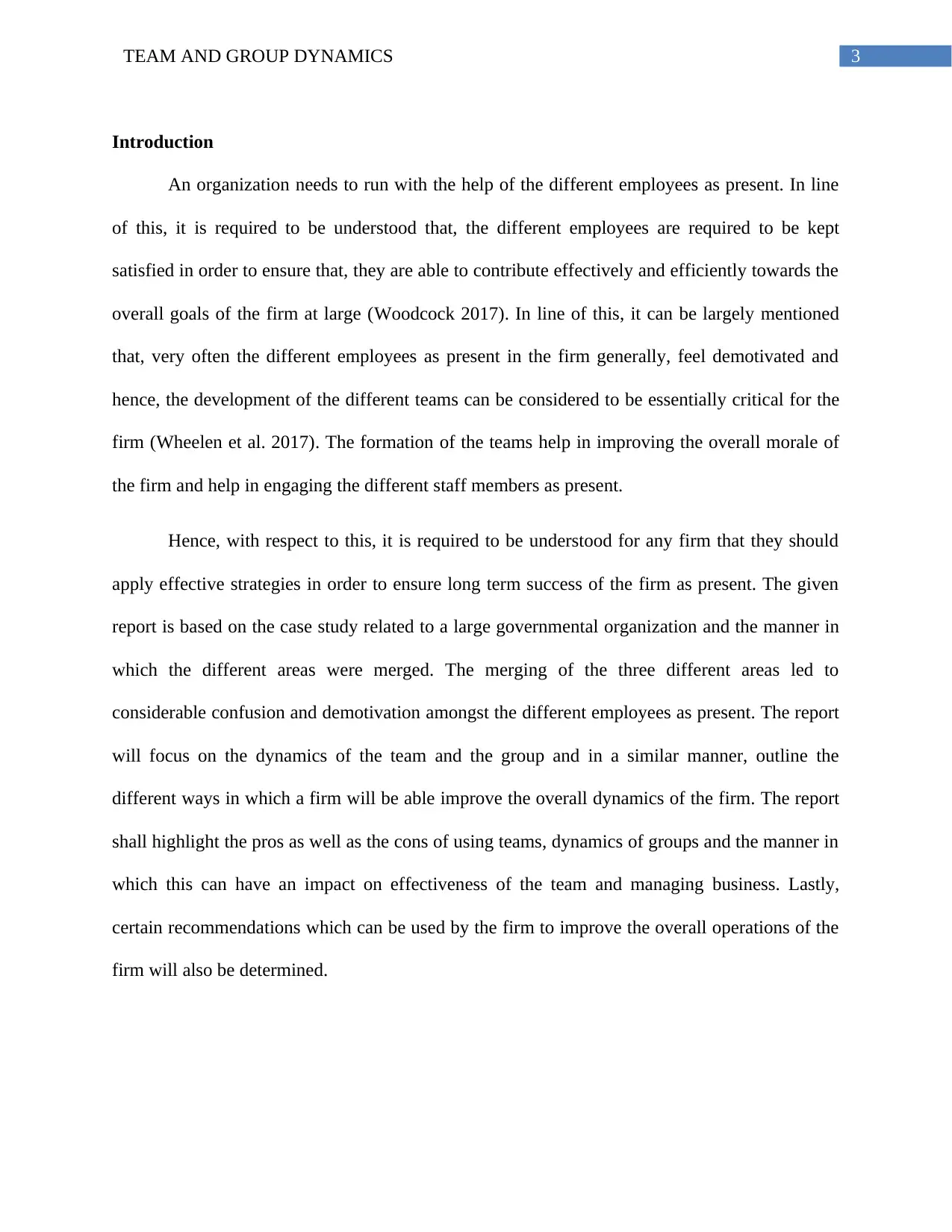
3TEAM AND GROUP DYNAMICS
Introduction
An organization needs to run with the help of the different employees as present. In line
of this, it is required to be understood that, the different employees are required to be kept
satisfied in order to ensure that, they are able to contribute effectively and efficiently towards the
overall goals of the firm at large (Woodcock 2017). In line of this, it can be largely mentioned
that, very often the different employees as present in the firm generally, feel demotivated and
hence, the development of the different teams can be considered to be essentially critical for the
firm (Wheelen et al. 2017). The formation of the teams help in improving the overall morale of
the firm and help in engaging the different staff members as present.
Hence, with respect to this, it is required to be understood for any firm that they should
apply effective strategies in order to ensure long term success of the firm as present. The given
report is based on the case study related to a large governmental organization and the manner in
which the different areas were merged. The merging of the three different areas led to
considerable confusion and demotivation amongst the different employees as present. The report
will focus on the dynamics of the team and the group and in a similar manner, outline the
different ways in which a firm will be able improve the overall dynamics of the firm. The report
shall highlight the pros as well as the cons of using teams, dynamics of groups and the manner in
which this can have an impact on effectiveness of the team and managing business. Lastly,
certain recommendations which can be used by the firm to improve the overall operations of the
firm will also be determined.
Introduction
An organization needs to run with the help of the different employees as present. In line
of this, it is required to be understood that, the different employees are required to be kept
satisfied in order to ensure that, they are able to contribute effectively and efficiently towards the
overall goals of the firm at large (Woodcock 2017). In line of this, it can be largely mentioned
that, very often the different employees as present in the firm generally, feel demotivated and
hence, the development of the different teams can be considered to be essentially critical for the
firm (Wheelen et al. 2017). The formation of the teams help in improving the overall morale of
the firm and help in engaging the different staff members as present.
Hence, with respect to this, it is required to be understood for any firm that they should
apply effective strategies in order to ensure long term success of the firm as present. The given
report is based on the case study related to a large governmental organization and the manner in
which the different areas were merged. The merging of the three different areas led to
considerable confusion and demotivation amongst the different employees as present. The report
will focus on the dynamics of the team and the group and in a similar manner, outline the
different ways in which a firm will be able improve the overall dynamics of the firm. The report
shall highlight the pros as well as the cons of using teams, dynamics of groups and the manner in
which this can have an impact on effectiveness of the team and managing business. Lastly,
certain recommendations which can be used by the firm to improve the overall operations of the
firm will also be determined.
Paraphrase This Document
Need a fresh take? Get an instant paraphrase of this document with our AI Paraphraser
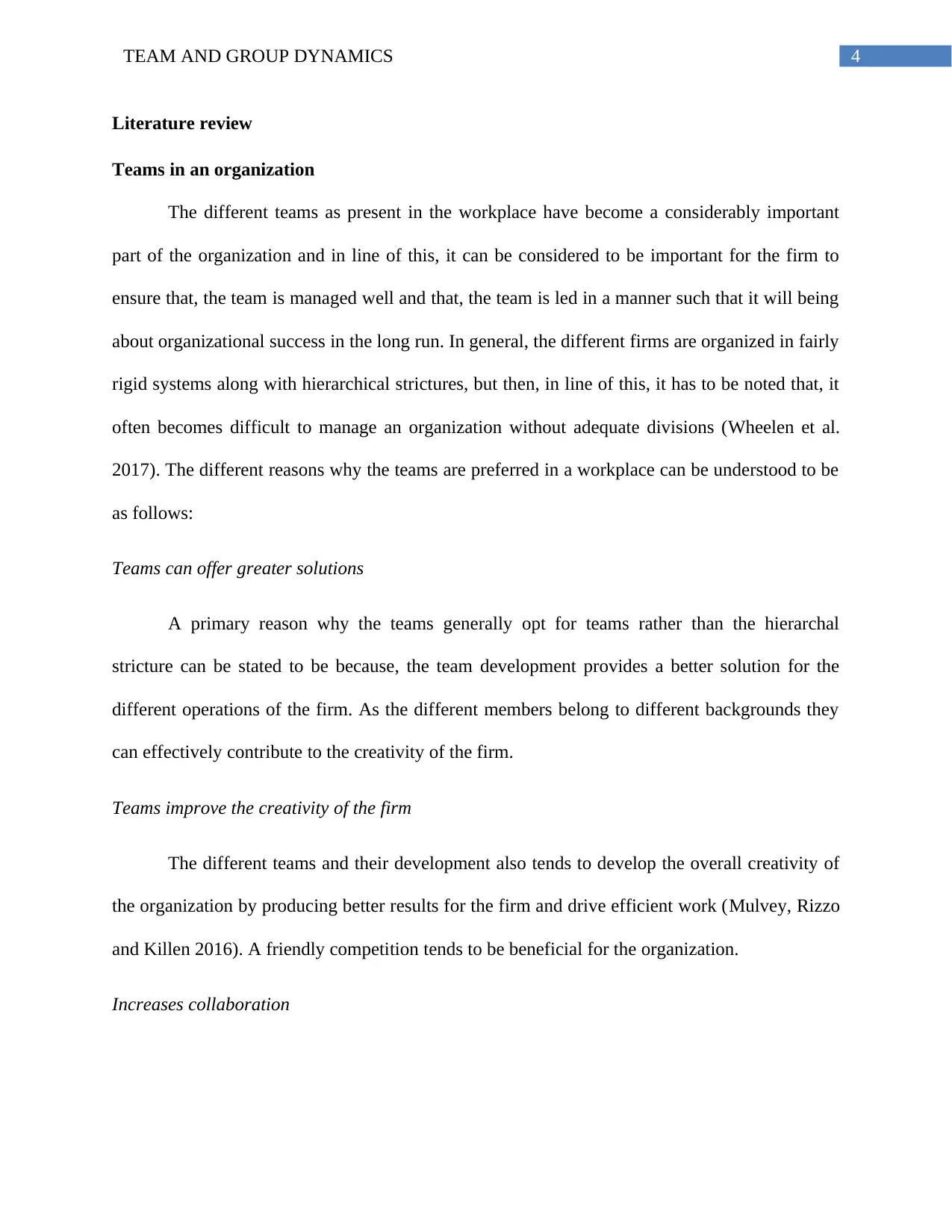
4TEAM AND GROUP DYNAMICS
Literature review
Teams in an organization
The different teams as present in the workplace have become a considerably important
part of the organization and in line of this, it can be considered to be important for the firm to
ensure that, the team is managed well and that, the team is led in a manner such that it will being
about organizational success in the long run. In general, the different firms are organized in fairly
rigid systems along with hierarchical strictures, but then, in line of this, it has to be noted that, it
often becomes difficult to manage an organization without adequate divisions (Wheelen et al.
2017). The different reasons why the teams are preferred in a workplace can be understood to be
as follows:
Teams can offer greater solutions
A primary reason why the teams generally opt for teams rather than the hierarchal
stricture can be stated to be because, the team development provides a better solution for the
different operations of the firm. As the different members belong to different backgrounds they
can effectively contribute to the creativity of the firm.
Teams improve the creativity of the firm
The different teams and their development also tends to develop the overall creativity of
the organization by producing better results for the firm and drive efficient work (Mulvey, Rizzo
and Killen 2016). A friendly competition tends to be beneficial for the organization.
Increases collaboration
Literature review
Teams in an organization
The different teams as present in the workplace have become a considerably important
part of the organization and in line of this, it can be considered to be important for the firm to
ensure that, the team is managed well and that, the team is led in a manner such that it will being
about organizational success in the long run. In general, the different firms are organized in fairly
rigid systems along with hierarchical strictures, but then, in line of this, it has to be noted that, it
often becomes difficult to manage an organization without adequate divisions (Wheelen et al.
2017). The different reasons why the teams are preferred in a workplace can be understood to be
as follows:
Teams can offer greater solutions
A primary reason why the teams generally opt for teams rather than the hierarchal
stricture can be stated to be because, the team development provides a better solution for the
different operations of the firm. As the different members belong to different backgrounds they
can effectively contribute to the creativity of the firm.
Teams improve the creativity of the firm
The different teams and their development also tends to develop the overall creativity of
the organization by producing better results for the firm and drive efficient work (Mulvey, Rizzo
and Killen 2016). A friendly competition tends to be beneficial for the organization.
Increases collaboration
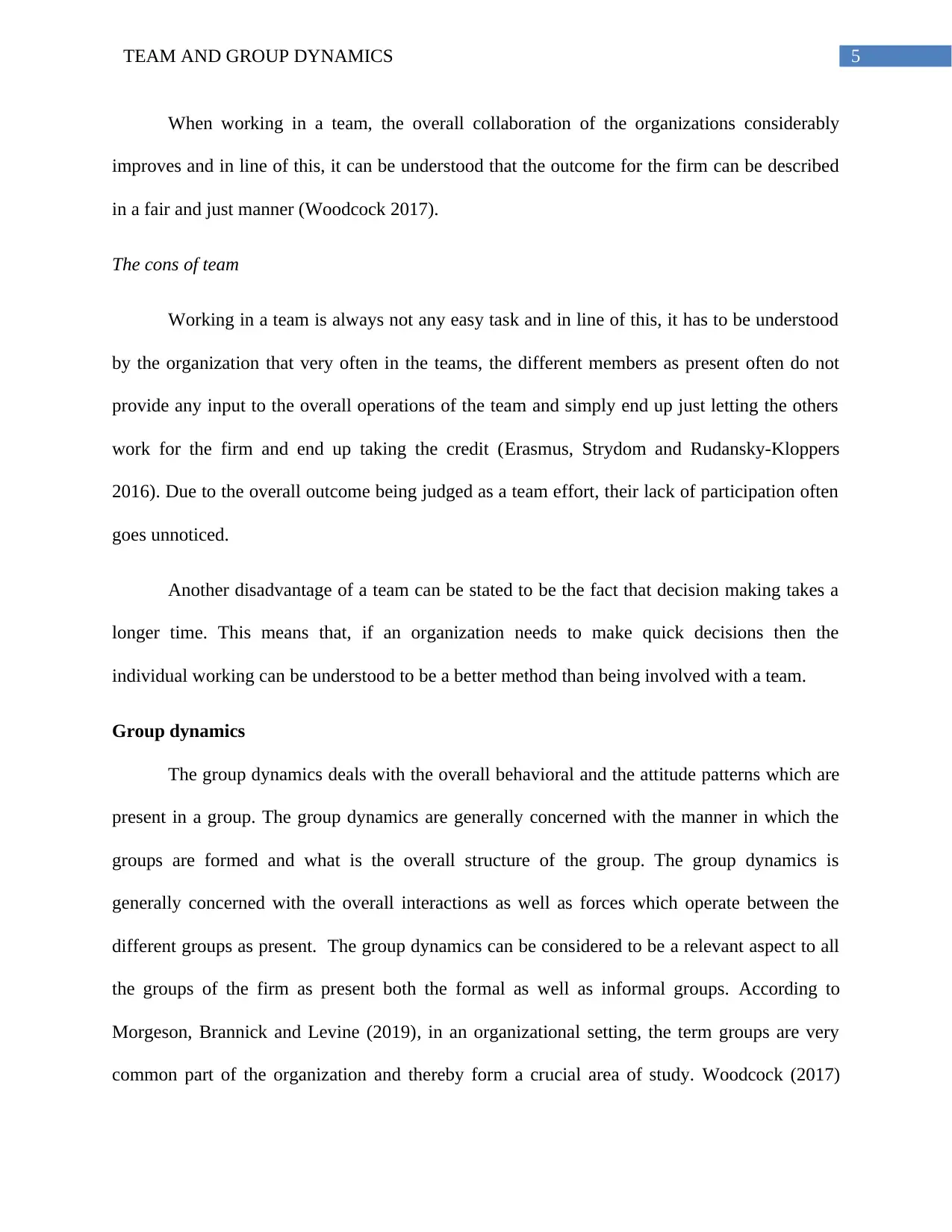
5TEAM AND GROUP DYNAMICS
When working in a team, the overall collaboration of the organizations considerably
improves and in line of this, it can be understood that the outcome for the firm can be described
in a fair and just manner (Woodcock 2017).
The cons of team
Working in a team is always not any easy task and in line of this, it has to be understood
by the organization that very often in the teams, the different members as present often do not
provide any input to the overall operations of the team and simply end up just letting the others
work for the firm and end up taking the credit (Erasmus, Strydom and Rudansky-Kloppers
2016). Due to the overall outcome being judged as a team effort, their lack of participation often
goes unnoticed.
Another disadvantage of a team can be stated to be the fact that decision making takes a
longer time. This means that, if an organization needs to make quick decisions then the
individual working can be understood to be a better method than being involved with a team.
Group dynamics
The group dynamics deals with the overall behavioral and the attitude patterns which are
present in a group. The group dynamics are generally concerned with the manner in which the
groups are formed and what is the overall structure of the group. The group dynamics is
generally concerned with the overall interactions as well as forces which operate between the
different groups as present. The group dynamics can be considered to be a relevant aspect to all
the groups of the firm as present both the formal as well as informal groups. According to
Morgeson, Brannick and Levine (2019), in an organizational setting, the term groups are very
common part of the organization and thereby form a crucial area of study. Woodcock (2017)
When working in a team, the overall collaboration of the organizations considerably
improves and in line of this, it can be understood that the outcome for the firm can be described
in a fair and just manner (Woodcock 2017).
The cons of team
Working in a team is always not any easy task and in line of this, it has to be understood
by the organization that very often in the teams, the different members as present often do not
provide any input to the overall operations of the team and simply end up just letting the others
work for the firm and end up taking the credit (Erasmus, Strydom and Rudansky-Kloppers
2016). Due to the overall outcome being judged as a team effort, their lack of participation often
goes unnoticed.
Another disadvantage of a team can be stated to be the fact that decision making takes a
longer time. This means that, if an organization needs to make quick decisions then the
individual working can be understood to be a better method than being involved with a team.
Group dynamics
The group dynamics deals with the overall behavioral and the attitude patterns which are
present in a group. The group dynamics are generally concerned with the manner in which the
groups are formed and what is the overall structure of the group. The group dynamics is
generally concerned with the overall interactions as well as forces which operate between the
different groups as present. The group dynamics can be considered to be a relevant aspect to all
the groups of the firm as present both the formal as well as informal groups. According to
Morgeson, Brannick and Levine (2019), in an organizational setting, the term groups are very
common part of the organization and thereby form a crucial area of study. Woodcock (2017)
⊘ This is a preview!⊘
Do you want full access?
Subscribe today to unlock all pages.

Trusted by 1+ million students worldwide

6TEAM AND GROUP DYNAMICS
defines the meaning of a group and states that, every organization can be understood to be a
group in itself and the group generally refers to approximately two or more individuals who
share a common meaning and have mutual goals as well as objectives. It can be understood to be
a collection of individuals who interact with one another and share a common identity.
Impact on group decision making effectiveness
According to Scarborough (2016), the when the different members in an organization
work together, they are required to make decisions influenced by the overall dynamics of the
group rather than the individual decision making. The group dynamics have a critical role to play
in the overall creativity as well as the quality of decision making which takes place. According to
Maylor, Blackmon and Huemann (2016), the teams which have a comparatively stronger
hierarchy are more efficient in the overall decision making and the teams which are disarrayed
do not necessarily take the different decisions in the right manner. The personal attributes like
the dominance, charisma and attractiveness tend to bring about an effective leader amongst the
different members of the firm and tends to form an effective group decision (Bratton and Gold
2017).
It is the duty of the group leader to diffuse the tension as present and allow the different
members of the firm to undertake effective decision making (Forsyth 2018). In line of this, it has
to be understood that, the right person has to be chosen for the right job and that, the leaders are
generally based on experience and not the factors like dominance or charisma. Hence, if the
group dynamics is prepared in the right manner, then in such a case, the decision making can be
stated to be accurate in nature (Brewster et al. 2016).
defines the meaning of a group and states that, every organization can be understood to be a
group in itself and the group generally refers to approximately two or more individuals who
share a common meaning and have mutual goals as well as objectives. It can be understood to be
a collection of individuals who interact with one another and share a common identity.
Impact on group decision making effectiveness
According to Scarborough (2016), the when the different members in an organization
work together, they are required to make decisions influenced by the overall dynamics of the
group rather than the individual decision making. The group dynamics have a critical role to play
in the overall creativity as well as the quality of decision making which takes place. According to
Maylor, Blackmon and Huemann (2016), the teams which have a comparatively stronger
hierarchy are more efficient in the overall decision making and the teams which are disarrayed
do not necessarily take the different decisions in the right manner. The personal attributes like
the dominance, charisma and attractiveness tend to bring about an effective leader amongst the
different members of the firm and tends to form an effective group decision (Bratton and Gold
2017).
It is the duty of the group leader to diffuse the tension as present and allow the different
members of the firm to undertake effective decision making (Forsyth 2018). In line of this, it has
to be understood that, the right person has to be chosen for the right job and that, the leaders are
generally based on experience and not the factors like dominance or charisma. Hence, if the
group dynamics is prepared in the right manner, then in such a case, the decision making can be
stated to be accurate in nature (Brewster et al. 2016).
Paraphrase This Document
Need a fresh take? Get an instant paraphrase of this document with our AI Paraphraser
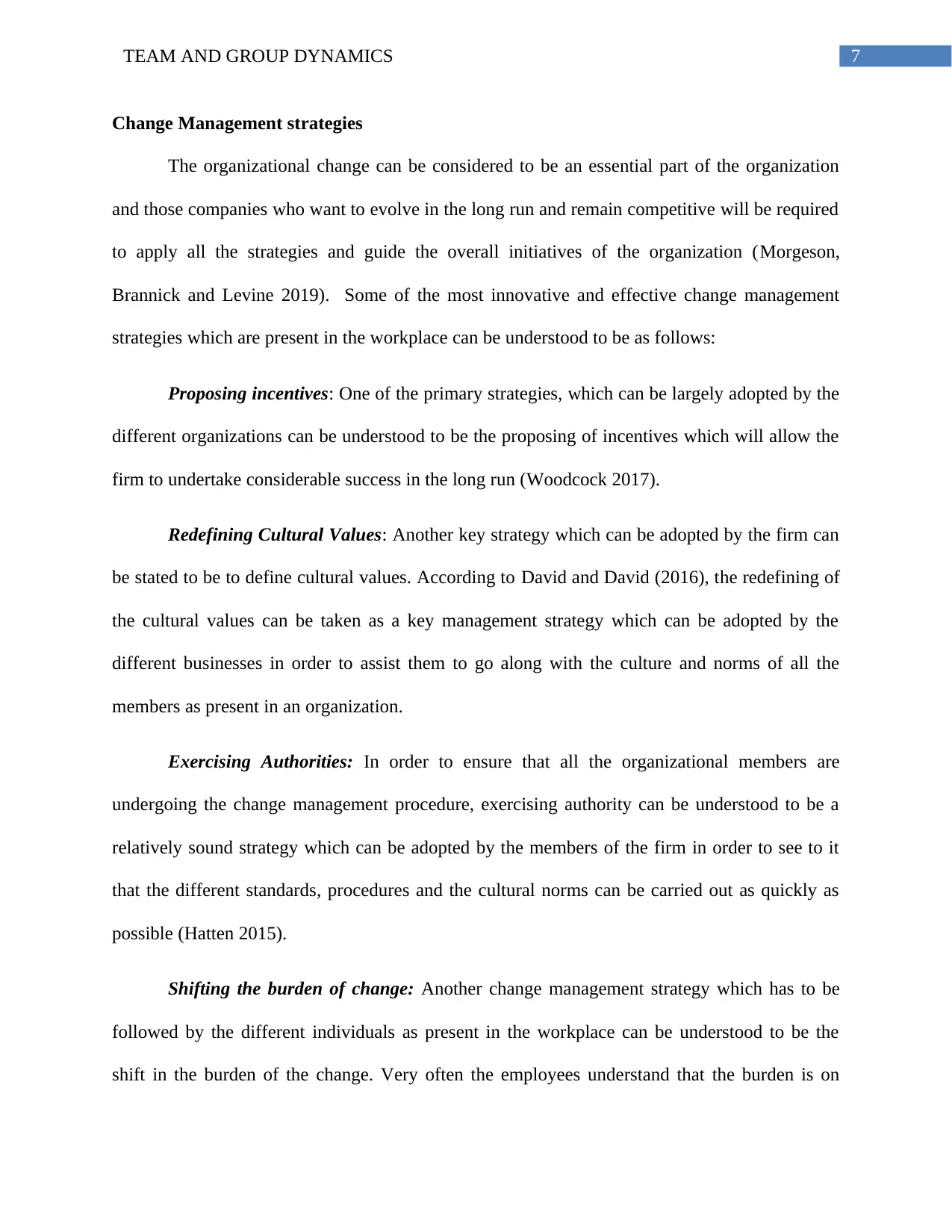
7TEAM AND GROUP DYNAMICS
Change Management strategies
The organizational change can be considered to be an essential part of the organization
and those companies who want to evolve in the long run and remain competitive will be required
to apply all the strategies and guide the overall initiatives of the organization (Morgeson,
Brannick and Levine 2019). Some of the most innovative and effective change management
strategies which are present in the workplace can be understood to be as follows:
Proposing incentives: One of the primary strategies, which can be largely adopted by the
different organizations can be understood to be the proposing of incentives which will allow the
firm to undertake considerable success in the long run (Woodcock 2017).
Redefining Cultural Values: Another key strategy which can be adopted by the firm can
be stated to be to define cultural values. According to David and David (2016), the redefining of
the cultural values can be taken as a key management strategy which can be adopted by the
different businesses in order to assist them to go along with the culture and norms of all the
members as present in an organization.
Exercising Authorities: In order to ensure that all the organizational members are
undergoing the change management procedure, exercising authority can be understood to be a
relatively sound strategy which can be adopted by the members of the firm in order to see to it
that the different standards, procedures and the cultural norms can be carried out as quickly as
possible (Hatten 2015).
Shifting the burden of change: Another change management strategy which has to be
followed by the different individuals as present in the workplace can be understood to be the
shift in the burden of the change. Very often the employees understand that the burden is on
Change Management strategies
The organizational change can be considered to be an essential part of the organization
and those companies who want to evolve in the long run and remain competitive will be required
to apply all the strategies and guide the overall initiatives of the organization (Morgeson,
Brannick and Levine 2019). Some of the most innovative and effective change management
strategies which are present in the workplace can be understood to be as follows:
Proposing incentives: One of the primary strategies, which can be largely adopted by the
different organizations can be understood to be the proposing of incentives which will allow the
firm to undertake considerable success in the long run (Woodcock 2017).
Redefining Cultural Values: Another key strategy which can be adopted by the firm can
be stated to be to define cultural values. According to David and David (2016), the redefining of
the cultural values can be taken as a key management strategy which can be adopted by the
different businesses in order to assist them to go along with the culture and norms of all the
members as present in an organization.
Exercising Authorities: In order to ensure that all the organizational members are
undergoing the change management procedure, exercising authority can be understood to be a
relatively sound strategy which can be adopted by the members of the firm in order to see to it
that the different standards, procedures and the cultural norms can be carried out as quickly as
possible (Hatten 2015).
Shifting the burden of change: Another change management strategy which has to be
followed by the different individuals as present in the workplace can be understood to be the
shift in the burden of the change. Very often the employees understand that the burden is on
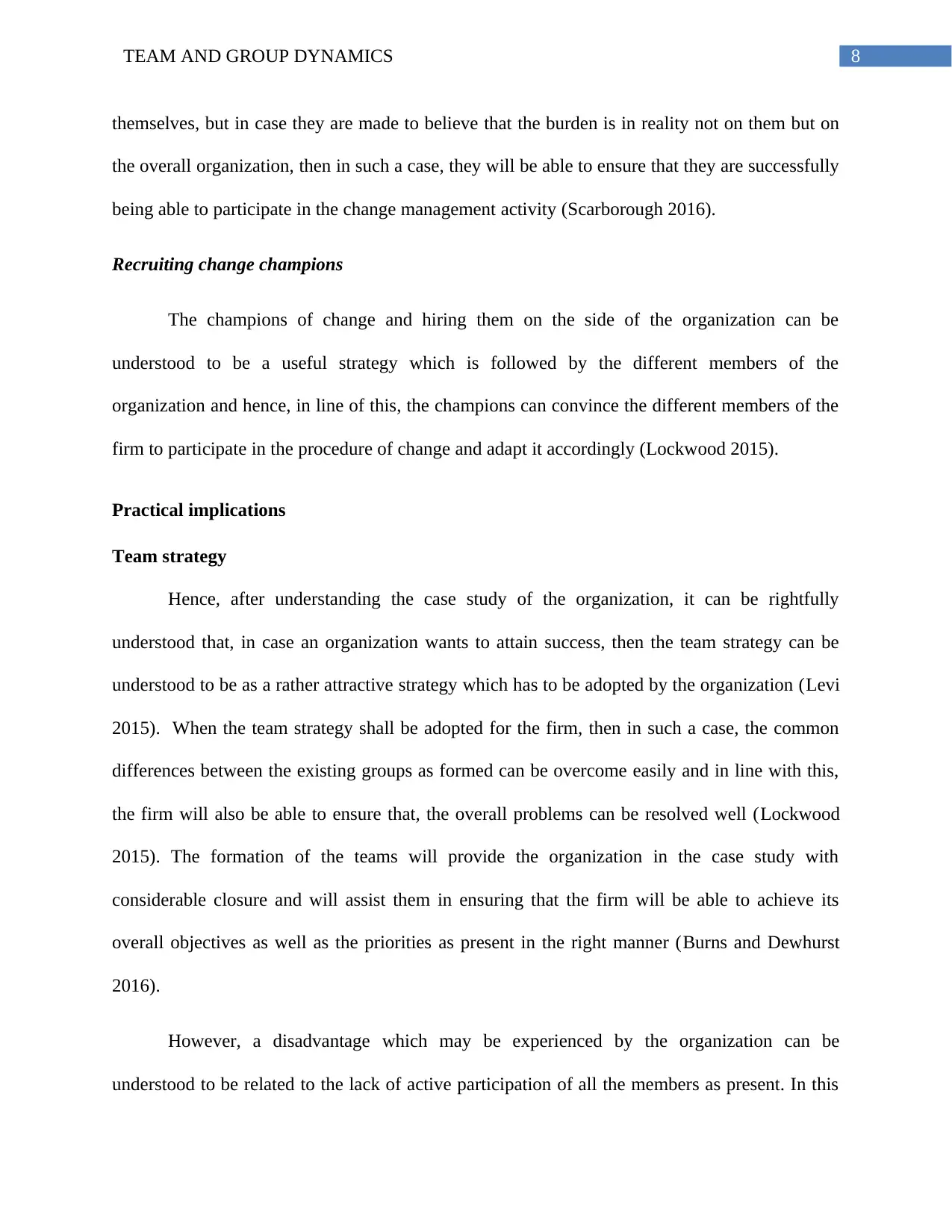
8TEAM AND GROUP DYNAMICS
themselves, but in case they are made to believe that the burden is in reality not on them but on
the overall organization, then in such a case, they will be able to ensure that they are successfully
being able to participate in the change management activity (Scarborough 2016).
Recruiting change champions
The champions of change and hiring them on the side of the organization can be
understood to be a useful strategy which is followed by the different members of the
organization and hence, in line of this, the champions can convince the different members of the
firm to participate in the procedure of change and adapt it accordingly (Lockwood 2015).
Practical implications
Team strategy
Hence, after understanding the case study of the organization, it can be rightfully
understood that, in case an organization wants to attain success, then the team strategy can be
understood to be as a rather attractive strategy which has to be adopted by the organization (Levi
2015). When the team strategy shall be adopted for the firm, then in such a case, the common
differences between the existing groups as formed can be overcome easily and in line with this,
the firm will also be able to ensure that, the overall problems can be resolved well (Lockwood
2015). The formation of the teams will provide the organization in the case study with
considerable closure and will assist them in ensuring that the firm will be able to achieve its
overall objectives as well as the priorities as present in the right manner (Burns and Dewhurst
2016).
However, a disadvantage which may be experienced by the organization can be
understood to be related to the lack of active participation of all the members as present. In this
themselves, but in case they are made to believe that the burden is in reality not on them but on
the overall organization, then in such a case, they will be able to ensure that they are successfully
being able to participate in the change management activity (Scarborough 2016).
Recruiting change champions
The champions of change and hiring them on the side of the organization can be
understood to be a useful strategy which is followed by the different members of the
organization and hence, in line of this, the champions can convince the different members of the
firm to participate in the procedure of change and adapt it accordingly (Lockwood 2015).
Practical implications
Team strategy
Hence, after understanding the case study of the organization, it can be rightfully
understood that, in case an organization wants to attain success, then the team strategy can be
understood to be as a rather attractive strategy which has to be adopted by the organization (Levi
2015). When the team strategy shall be adopted for the firm, then in such a case, the common
differences between the existing groups as formed can be overcome easily and in line with this,
the firm will also be able to ensure that, the overall problems can be resolved well (Lockwood
2015). The formation of the teams will provide the organization in the case study with
considerable closure and will assist them in ensuring that the firm will be able to achieve its
overall objectives as well as the priorities as present in the right manner (Burns and Dewhurst
2016).
However, a disadvantage which may be experienced by the organization can be
understood to be related to the lack of active participation of all the members as present. In this
⊘ This is a preview!⊘
Do you want full access?
Subscribe today to unlock all pages.

Trusted by 1+ million students worldwide
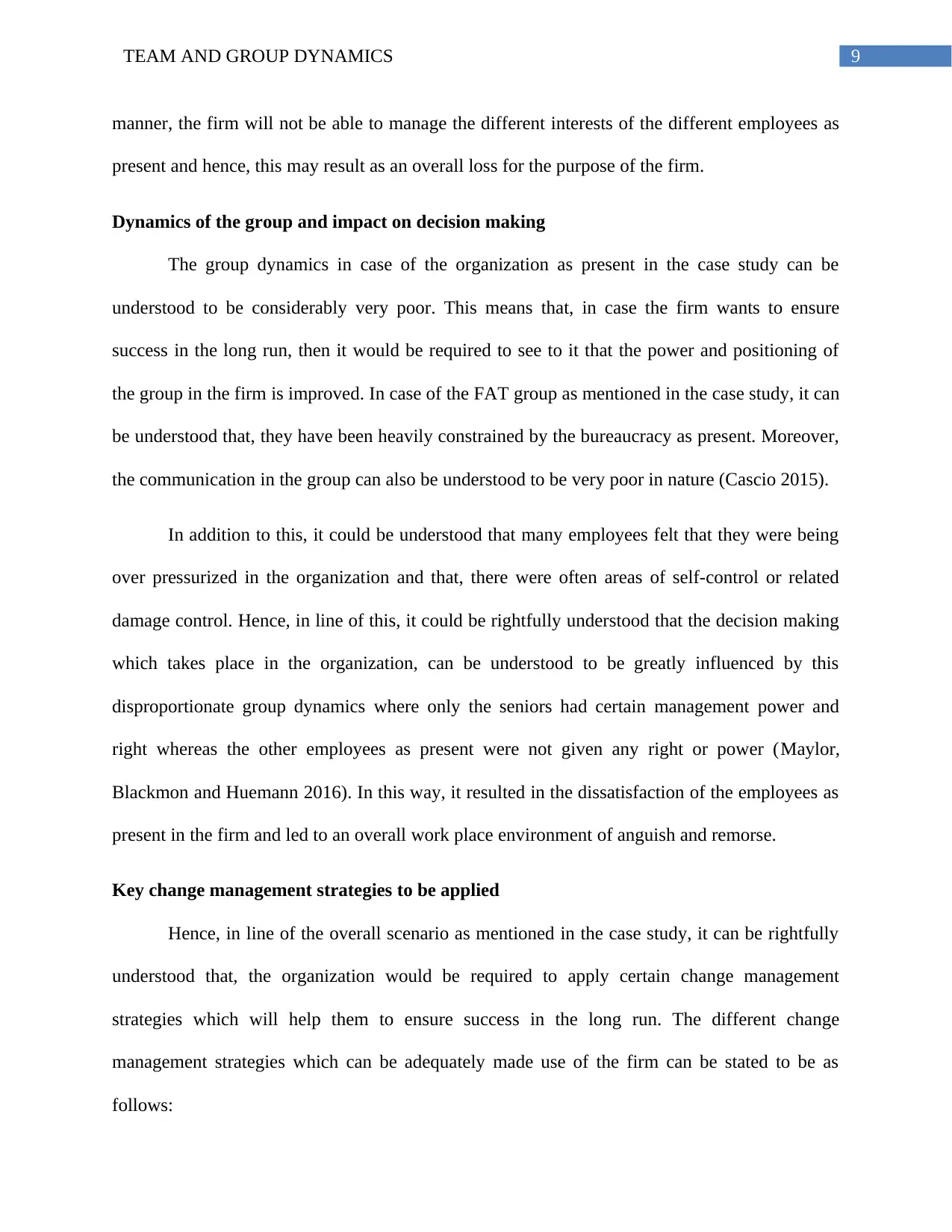
9TEAM AND GROUP DYNAMICS
manner, the firm will not be able to manage the different interests of the different employees as
present and hence, this may result as an overall loss for the purpose of the firm.
Dynamics of the group and impact on decision making
The group dynamics in case of the organization as present in the case study can be
understood to be considerably very poor. This means that, in case the firm wants to ensure
success in the long run, then it would be required to see to it that the power and positioning of
the group in the firm is improved. In case of the FAT group as mentioned in the case study, it can
be understood that, they have been heavily constrained by the bureaucracy as present. Moreover,
the communication in the group can also be understood to be very poor in nature (Cascio 2015).
In addition to this, it could be understood that many employees felt that they were being
over pressurized in the organization and that, there were often areas of self-control or related
damage control. Hence, in line of this, it could be rightfully understood that the decision making
which takes place in the organization, can be understood to be greatly influenced by this
disproportionate group dynamics where only the seniors had certain management power and
right whereas the other employees as present were not given any right or power (Maylor,
Blackmon and Huemann 2016). In this way, it resulted in the dissatisfaction of the employees as
present in the firm and led to an overall work place environment of anguish and remorse.
Key change management strategies to be applied
Hence, in line of the overall scenario as mentioned in the case study, it can be rightfully
understood that, the organization would be required to apply certain change management
strategies which will help them to ensure success in the long run. The different change
management strategies which can be adequately made use of the firm can be stated to be as
follows:
manner, the firm will not be able to manage the different interests of the different employees as
present and hence, this may result as an overall loss for the purpose of the firm.
Dynamics of the group and impact on decision making
The group dynamics in case of the organization as present in the case study can be
understood to be considerably very poor. This means that, in case the firm wants to ensure
success in the long run, then it would be required to see to it that the power and positioning of
the group in the firm is improved. In case of the FAT group as mentioned in the case study, it can
be understood that, they have been heavily constrained by the bureaucracy as present. Moreover,
the communication in the group can also be understood to be very poor in nature (Cascio 2015).
In addition to this, it could be understood that many employees felt that they were being
over pressurized in the organization and that, there were often areas of self-control or related
damage control. Hence, in line of this, it could be rightfully understood that the decision making
which takes place in the organization, can be understood to be greatly influenced by this
disproportionate group dynamics where only the seniors had certain management power and
right whereas the other employees as present were not given any right or power (Maylor,
Blackmon and Huemann 2016). In this way, it resulted in the dissatisfaction of the employees as
present in the firm and led to an overall work place environment of anguish and remorse.
Key change management strategies to be applied
Hence, in line of the overall scenario as mentioned in the case study, it can be rightfully
understood that, the organization would be required to apply certain change management
strategies which will help them to ensure success in the long run. The different change
management strategies which can be adequately made use of the firm can be stated to be as
follows:
Paraphrase This Document
Need a fresh take? Get an instant paraphrase of this document with our AI Paraphraser
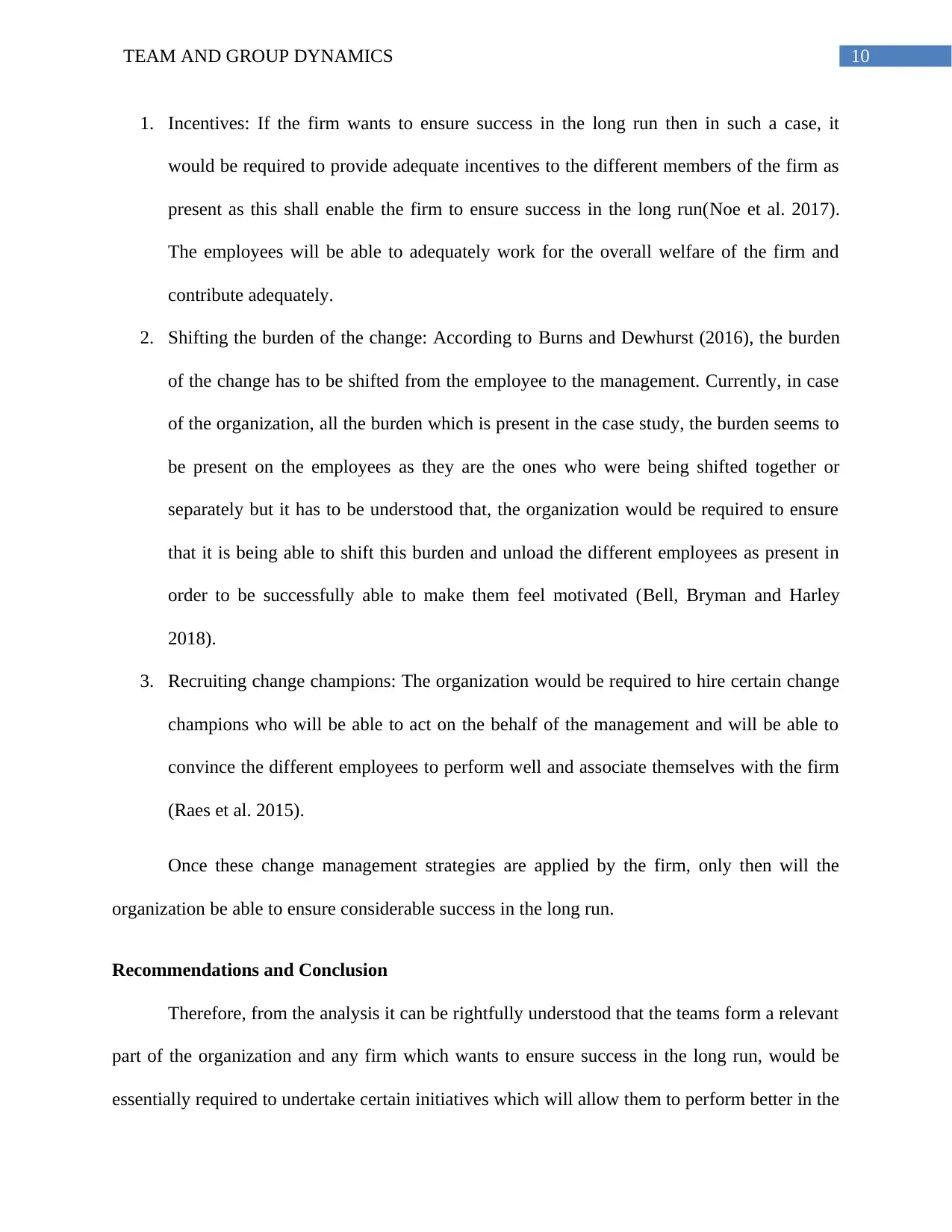
10TEAM AND GROUP DYNAMICS
1. Incentives: If the firm wants to ensure success in the long run then in such a case, it
would be required to provide adequate incentives to the different members of the firm as
present as this shall enable the firm to ensure success in the long run(Noe et al. 2017).
The employees will be able to adequately work for the overall welfare of the firm and
contribute adequately.
2. Shifting the burden of the change: According to Burns and Dewhurst (2016), the burden
of the change has to be shifted from the employee to the management. Currently, in case
of the organization, all the burden which is present in the case study, the burden seems to
be present on the employees as they are the ones who were being shifted together or
separately but it has to be understood that, the organization would be required to ensure
that it is being able to shift this burden and unload the different employees as present in
order to be successfully able to make them feel motivated (Bell, Bryman and Harley
2018).
3. Recruiting change champions: The organization would be required to hire certain change
champions who will be able to act on the behalf of the management and will be able to
convince the different employees to perform well and associate themselves with the firm
(Raes et al. 2015).
Once these change management strategies are applied by the firm, only then will the
organization be able to ensure considerable success in the long run.
Recommendations and Conclusion
Therefore, from the analysis it can be rightfully understood that the teams form a relevant
part of the organization and any firm which wants to ensure success in the long run, would be
essentially required to undertake certain initiatives which will allow them to perform better in the
1. Incentives: If the firm wants to ensure success in the long run then in such a case, it
would be required to provide adequate incentives to the different members of the firm as
present as this shall enable the firm to ensure success in the long run(Noe et al. 2017).
The employees will be able to adequately work for the overall welfare of the firm and
contribute adequately.
2. Shifting the burden of the change: According to Burns and Dewhurst (2016), the burden
of the change has to be shifted from the employee to the management. Currently, in case
of the organization, all the burden which is present in the case study, the burden seems to
be present on the employees as they are the ones who were being shifted together or
separately but it has to be understood that, the organization would be required to ensure
that it is being able to shift this burden and unload the different employees as present in
order to be successfully able to make them feel motivated (Bell, Bryman and Harley
2018).
3. Recruiting change champions: The organization would be required to hire certain change
champions who will be able to act on the behalf of the management and will be able to
convince the different employees to perform well and associate themselves with the firm
(Raes et al. 2015).
Once these change management strategies are applied by the firm, only then will the
organization be able to ensure considerable success in the long run.
Recommendations and Conclusion
Therefore, from the analysis it can be rightfully understood that the teams form a relevant
part of the organization and any firm which wants to ensure success in the long run, would be
essentially required to undertake certain initiatives which will allow them to perform better in the
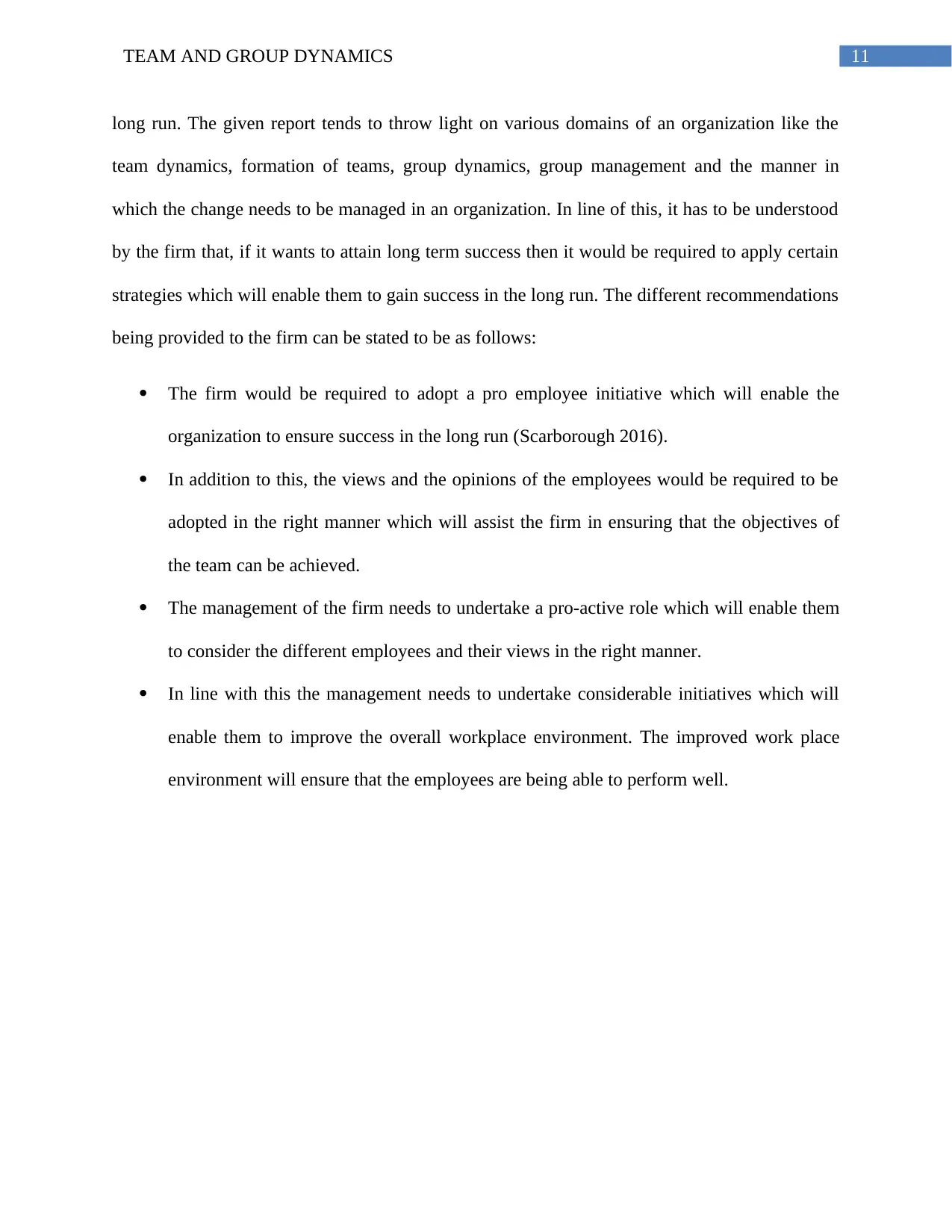
11TEAM AND GROUP DYNAMICS
long run. The given report tends to throw light on various domains of an organization like the
team dynamics, formation of teams, group dynamics, group management and the manner in
which the change needs to be managed in an organization. In line of this, it has to be understood
by the firm that, if it wants to attain long term success then it would be required to apply certain
strategies which will enable them to gain success in the long run. The different recommendations
being provided to the firm can be stated to be as follows:
The firm would be required to adopt a pro employee initiative which will enable the
organization to ensure success in the long run (Scarborough 2016).
In addition to this, the views and the opinions of the employees would be required to be
adopted in the right manner which will assist the firm in ensuring that the objectives of
the team can be achieved.
The management of the firm needs to undertake a pro-active role which will enable them
to consider the different employees and their views in the right manner.
In line with this the management needs to undertake considerable initiatives which will
enable them to improve the overall workplace environment. The improved work place
environment will ensure that the employees are being able to perform well.
long run. The given report tends to throw light on various domains of an organization like the
team dynamics, formation of teams, group dynamics, group management and the manner in
which the change needs to be managed in an organization. In line of this, it has to be understood
by the firm that, if it wants to attain long term success then it would be required to apply certain
strategies which will enable them to gain success in the long run. The different recommendations
being provided to the firm can be stated to be as follows:
The firm would be required to adopt a pro employee initiative which will enable the
organization to ensure success in the long run (Scarborough 2016).
In addition to this, the views and the opinions of the employees would be required to be
adopted in the right manner which will assist the firm in ensuring that the objectives of
the team can be achieved.
The management of the firm needs to undertake a pro-active role which will enable them
to consider the different employees and their views in the right manner.
In line with this the management needs to undertake considerable initiatives which will
enable them to improve the overall workplace environment. The improved work place
environment will ensure that the employees are being able to perform well.
⊘ This is a preview!⊘
Do you want full access?
Subscribe today to unlock all pages.

Trusted by 1+ million students worldwide
1 out of 16
Related Documents
Your All-in-One AI-Powered Toolkit for Academic Success.
+13062052269
info@desklib.com
Available 24*7 on WhatsApp / Email
![[object Object]](/_next/static/media/star-bottom.7253800d.svg)
Unlock your academic potential
Copyright © 2020–2025 A2Z Services. All Rights Reserved. Developed and managed by ZUCOL.





